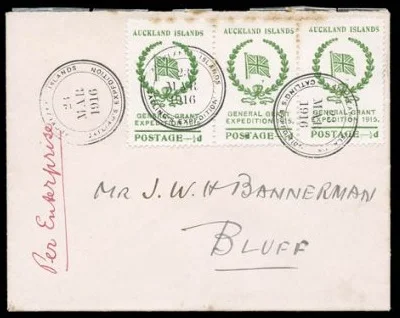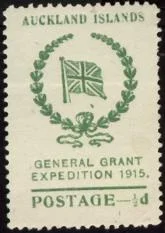A Set of two values issued for the Catling Expedition of 1915/16 to salvage the gold and cargo of the General Grant which had struck the cliffs of the Auckland Islands many years before. These stamps are a very sought after collector's items and can fetch high prices on the rare occasions when they come up for sale. (As of Mar 2016, the two stamps above would be worth approx. $140.00 NZ each)
The Wreck of the General Grant.
In 1866, while on her way from Melbourne to London, General Grant crashed into a cliff on the west coast of the main island of the Auckland Islands of New Zealand, and subsequently sank as a result. At first, the ship remained afloat but after being driven into a large cave the rising tide and increasing swell caused the main mast to hit the cave roof repeatedly until the mast forced a hole through the hull sinking the ship. 68 people were killed during the sinking, but 15 people were able to escape the sinking ship.
It is said that the General Grant carried a large amount off gold bars instead of the zinc ballast stated on the ship's manifest, but this has never been officially confirmed. Over the years there have been a number of expeditions to find the ship and retrieve any gold, but these have always proved unsuccessful, often with loss of life among the teams involved.
The Stamps.
What concerns us in this post are the stamps (labels) produced for the Catling's Salvage Expedition of 1915/16.
The stamps were printed individually resulting many examples of images being out of alignment. The perforations were set up poorly resulting in different sized stamps as can be seen above. From what I have seen the printing seems very poorly done on inferior paper.
Only two values were produced, each being similar but slightly different in the arrangement of the various elements within the design. There is nothing outstanding about the designs, just purpose-built to display required information.
A cover addressed to Bluff in New Zealand showing 3 of the ½d value with expedition cancels from 1916.
The two values on piece, again showing the expedition cancels.
The cancel says, "Auckland Islands - Catling's Expedition."
The date: - day - month - year is in the centre.
The stamps were supposed to have been printed in sheets of 24 as is shown here with both values but without the selvedge still being attached, it is hard to be sure if this was actually the case. The stamp images were applied one at a time which mean positioned varied across the sheet.
Now in this next sheet below it can be seen that the image in the bottom-left corner is way out of aliment running over onto the stamps beside it.
Below are three more examples of misaligned stamp images.
In this corner pair of the 1d value, the left-hand one has moved right out over into the sheet selvedge.
Two examples of the ½d Green showing image shifts.
Finally, I've left the best until last. Here is a block of four ½d stamps with fairly well-placed images that has a fifth image placed across them. It is only due to the single image printing process that this could ever happen. Also, notice the very poor quality of the perforating which has led to the torn appearance of the stamps.














You always have something interesting that I haven't seen before.
ReplyDeleteHow did you find these Allan?
Brian
We appreciate your engagement with our content. To ensure a respectful and constructive community, please take note of the following:
- No Spam, Please: We do not tolerate spammy or promotional comments. Any such comments will be promptly removed.
- Moderation in Place: All comments are moderated to maintain a positive and inclusive environment. Please be patient, as it may take a little time for your comment to appear.
- Sign In with Google: To comment, please sign in using your Google account. This helps us maintain the integrity of our community and allows for better interaction.